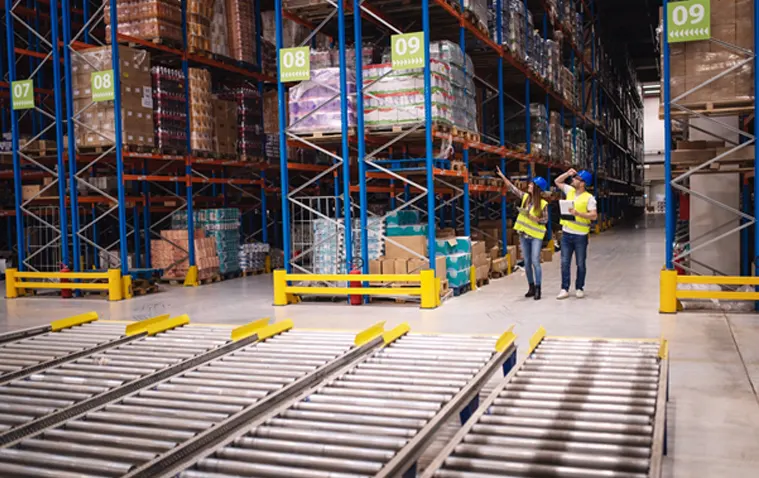Bluetooth Low Energy (BLE) technology enhances the safety of workplaces by capturing vital information, such as location, movement, temperature, ambient light, humidity, etc.
In recent years, studies have indicated that location-tracking system enabled by BLE beacons technology helps address the health and safety concerns of workers, especially in settings that pose greater risks, such as construction sites, mines, or large-scale manufacturing facilities.
To that end, this article explores the viability of BLE tags in creating safer workplaces.

Why Use BLE Tags for Workers’ Safety?
Although a number of workplace safety regulations have been put in place, concerns regarding worker safety persist. According to International Labour Organisation (ILO), around 340 million occupational accidents happen every year.
Trips, slips, and falls are the most common hazards at workplaces. But regardless of the nature of the risk, reaction time is key to mitigating workplace injuries, alongside preventive measures. For that, it’s essential that someone notifies about the emergency immediately – precisely where BLE tags can help.
With BLE tags, it becomes easier to collect data regarding the location and movement of objects and employees to establish analytical models and make better decisions for workers’ safety. Besides, BLE beacons and tags are inexpensive and scalable solutions; they are easy to install and use and also provide wider position monitoring.
Now, let’s get into the nitty-gritty of how BLE tags contribute to the creation of a safer workplace.
Locate Employees Spread Across Facilities (Especially During Emergencies)
Locating employees spread across large facilities is often a concern, especially during an emergency. However, with BLE tags, the physical location data is transmitted to the receiver for quick location tracking. In the instance of an emergency, this setup works with sensors to position employees.
BLE tags also help in tracking people trapped inside a facility. Personnel badges with a panic button send SOS in duress. And badges with motion sensors send signals to monitor workers in remote and dangerous locations. Such tracking systems monitor the security zones between people and forklifts and send alerts to prevent collisions.
With tracking technologies becoming mainstream, BLE tags and devices stand as the most reliable tracking components for accuracy and convenience. All the major sectors, including healthcare, manufacturing, retail, logistics, transportation, and supply chain, can deploy tags to track and locate their employees across facilities.
Visitor Management
Post-COVID-19, it is imperative to maintain a seamless and contactless visitor management system across industries. With RFID technology, businesses can ensure contactless entry of employees and visitors across premises for better safety, control, and management. They can monitor and track every visitor moving through the building using RFID BLE tags.
The RFID and BLE technology work together to ensure reduced risk of contact and infection. No manual registration is required. They also help organisations to assign specific areas or buildings within the office premises for guest arrival. BLE technology monitors the hours of dwelling and visits to other non-allocated areas and notifies instantly.
In fact, BLE systems are capable of tracking visitors’ movement right from their entry till they exit the premises — thus, helping in better management of the entire premises.
Rule-Based Access Alert
BLE tags ensure that employees are aware of their access limitations. Employees are informed whenever they enter any restricted areas. As a result, tags ensure that unqualified staff does not get access to restricted areas.
For instance, BLE tags determine whether a machine operator is within the authorised area. They send an alert to the concerned personnel when an operator enters a zone without the necessary authorisation. This is the proximity alarm feature that ascertains every individual within the defined zone possesses the required skills and is authorised to be in that area.
In addition, this Bluetooth technology can also be used for turning on and off some instrument functions and control settings and even sending notifications.
Fall Detection
Employees benefit from the latest BLE tags in many ways. Besides tracing capabilities, they are integral to the fall detection system. Facility personnel working in positions involving high levels of risk can press the panic button to send an alert right before the fall. This instantly sends security alerts and informs the team of the individual’s location.
BLE tags combined with motion sensors are used in construction sites, hospitals, and nursing homes, for fall detection. When the motion sensor detects a fall, the connected BLE device immediately raises the alarm with all the information about employees in danger with their GPS location for immediate help.
Advanced Warning About Machine Failures
BLE tags and beacons collect precise and continuous data for useful analysis. They can be easily mounted on static locations or moving platforms like heavy machinery and forklifts. Beacons can also be deployed and used for sending warnings or alerts when there is an inconsistency in pieces of machinery or their movement, which could otherwise cause disruption. The idea is to inform the workers when there is a risk of machine failure.
Conclusion
When armed with new-age BLE technology and devices, businesses can create safer workplaces. This significantly increases cohesion in the workplace and fosters long-lasting relationships with employees.
At QodeNext, we focus on helping businesses nurture a BLE-powered safe workplace. Connect with us to learn more about our offerings.







